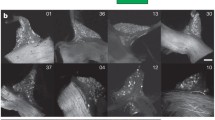Abstract
Solutions of table salt (NaCl) elicit several tastes, including of course saltiness but also sweet, sour, and bitter. This brief review touches on some of the mileposts concerning what is known about taste transduction for the Na+ ion, the main contributor to saltiness. Electrophysiological recordings, initially from single gustatory nerve fibers, and later, integrated impulse activity from gustatory nerves led researchers to predict that Na+ ions interacted with a surface molecule. Subsequent studies have resolved that this molecule is likely to be an epithelial sodium channel, ENaC. Other Na+ transduction mechanisms are also present in taste buds but have not yet been identified. The specific type(s) of taste cells responsible for salt taste also remains unknown.







Similar content being viewed by others
References
Abrahams H, Krakauer D, Dallenbach KM (1937) Gustatory adaptation to salt. Am J Psychol 49:462–469. doi:10.2307/1415781
Avenet P, Lindemann B (1988) Amiloride-blockable sodium currents in isolated taste receptor cells. J Membr Biol 105:245–255. doi:10.1007/BF01871001
Bartoshuk LM, McBurney DH, Pfaffmann C (1964) Taste of sodium chloride solutions after adaptation to sodium chloride: implications for the “water taste”. Science 143:967–968. doi:10.1126/science.143.3609.967
Bartoshuk LM, Murphy C, Cleveland CT (1978) Sweet taste of dilute NaCl: psychophysical evidence for a sweet stimulus. Physiol Behav 21:609–613. doi:10.1016/00319384(78)90138-5
Beidler LM (1953) Properties of chemoreceptors of tongue of rat. J Neurophysiol 16:595–607
Beidler LM (1954) A theory of taste stimulation. J Gen Physiol 38:133–139. doi:10.1085/jgp.38.2.133
Chandrashekar J, Kuhn C, Oka Y, Yarmolinsky DA, Hummler E, Ryba NJ, Zuker CS (2010) The cells and peripheral representation of sodium taste in mice. Nature 464:297–301. doi:10.1038/nature08783
Chaudhari N (2014) Synaptic communication and signal processing among sensory cells in taste buds. J Physiol 592:3387–3392. doi:10.1113/jphysiol.2013.269837
Chaudhari N, Roper SD (2010) The cell biology of taste. J Cell Biol 190:285–296. doi:10.1083/jcb.201003144
Gilbertson TA, Zhang H (1998) Self-inhibition in amiloride-sensitive sodium channels in taste receptor cells. J Gen Physiol 111:667–677. doi:10.1085/jgp.111.5.667
Halpern BP, Tapper DN (1971) Taste stimuli: quality coding time. Science 171:1256–1258. doi:10.1126/science.171.3977.1256
Heck GL, Mierson S, DeSimone JA (1984) Salt taste transduction occurs through an amiloride-sensitive sodium transport pathway. Science 223:403–405. doi:10.1126/science.6691151
Kelling ST, Halpern BP (1983) Taste flashes: reaction times, intensity, and quality. Science 219:412–414. doi:10.1126/science.6849142
Kretz O, Barbry P, Bock R, Lindemann B (1999) Differential expression of RNA and protein of the three pore-forming subunits of the amiloride-sensitive epithelial sodium channel in taste buds of the rat. J Histochem Cytochem 47:51–64. doi:10.1177/002215549904700106
Lewandowski BS, Sukumaran SK, Margolskee RF, Bachmanov AA (2014) Anion effect and osmotic sensitivity of salt-responsive taste bud cells isolated from mouse circumvallate papillae. In: Society for Neuroscience Abstracts, Society for Neuroscience, Washington, DC, 15–18 November 2014
Lin W, Finger TE, Rossier BC, Kinnamon SC (1999) Epithelial Na+ channel subunits in rat taste cells: localization and regulation by aldosterone. J Comp Neurol 405:406–420. doi:10.1002/(SICI)1096-9861(19990315)405:3<406::AID-CNE10>3.0.CO;2-F
Lyall V, Heck GL, Vinnikova AK, Ghosh S, Phan TH, Alam RI, Russell OF, Malik SA, Bigbee JW, DeSimone JA (2004) The mammalian amiloride-insensitive non-specific salt taste receptor is a vanilloid receptor-1 variant. J Physiol 558:147–159. doi:10.1113/jphysiol.2004.065656
Miyamoto T, Fujiyama R, Okada Y, Sato T (1999) Strain difference in amiloride-sensitivity of salt-induced responses in mouse non-dissociated taste cells. Neurosci Lett 277:13–16. doi:10.1016/S0304-3940(99)00828-9
Oka Y, Butnaru M, von Buchholtz L, Ryba NJ, Zuker CS (2013) High salt recruits aversive taste pathways. Nature 494:472–475. doi:10.1038/nature11905
Ossebaard CA, Smith DV (1995) Effect of amiloride on the taste of NaCl, Na-gluconate and KCl in humans: implications for Na+ receptor mechanisms. Chem Senses 20:37–46. doi:10.1093/chemse/20.1.37
Pfaffman C (1939) Specific gustatory impulses. J Physiol 96:41P–42P
Pumphrey RJ (1935) Nerve impulses from receptors in the mouth of the frog. J Cell Comp Physiol 6:457–467. doi:10.1002/jcp.1030060310
Roper SD (2013) Taste buds as peripheral chemosensory processors. Semin Cell Dev Biol 24:71–79. doi:10.1016/j.semcdb.2012.12.002
Ruiz C, Gutknecht S, Delay E, Kinnamon S (2006) Detection of NaCl and KCl in TRPV1 knockout mice. Chem Senses 31:813–820. doi:10.1093/chemse/bjl024
Schiffman SS, Lockhead E, Maes FW (1983) Amiloride reduces the taste intensity of Na+ and Li+ salts and sweeteners. Proc Natl Acad Sci U S A 80:6136–6140
Tomchik SM, Berg S, Kim JW, Chaudhari N, Roper SD (2007) Breadth of tuning and taste coding in mammalian taste buds. J Neurosci 27:10840–10848. doi:10.1523/JNEUROSCI. 1863-07.2007
Tonosaki K, Funakoshi M (1988) Cyclic nucleotides may mediate taste transduction. Nature 331:354–356. doi:10.1038/331354a0
Treesukosol Y, Lyall V, Heck GL, DeSimone JA, Spector AC (2007) A psychophysical and electrophysiological analysis of salt taste in Trpv1 null mice. Am J Physiol Regul Integr Comp Physiol 292:R1799–R1809. doi:10.1152/ajpregu.00587.2006
Vandenbeuch A, Clapp TR, Kinnamon SC (2008) Amiloride-sensitive channels in type I fungiform taste cells in mouse. BMC Neurosci 9:1. doi:10.1186/1471-2202-9-1
Yee KK, Sukumaran SK, Kotha R, Gilbertson TA, Margolskee RF (2011) Glucose transporters and ATP-gated K+ (KATP) metabolic sensors are present in type 1 taste receptor 3 (T1r3)-expressing taste cells. Proc Natl Acad Sci U S A 108:5431–5436. doi:10.1073/pnas.1100495108
Yoshida R, Shigemura N, Sanematsu K, Yasumatsu K, Ishizuka S, Ninomiya Y (2006) Taste responsiveness of fungiform taste cells with action potentials. J Neurophysiol 96:3088–3095. doi:10.1152/jn.00409.2006
Yoshida R, Horio N, Murata Y, Yasumatsu K, Shigemura N, Ninomiya Y (2009) NaCl responsive taste cells in the mouse fungiform taste buds. Neuroscience 159:795–803. doi:10.1016/j.neuroscience.2008.12.052
Zotterman Y (1935) Action potentials in the glossopharyngeal nerve and in the chorda tympani. Skand Arch Physiol 72:73–77. doi:10.1111/j.1748-1716.1935.tb00412.x
Author information
Authors and Affiliations
Corresponding author
Rights and permissions
About this article
Cite this article
Roper, S.D. The taste of table salt. Pflugers Arch - Eur J Physiol 467, 457–463 (2015). https://doi.org/10.1007/s00424-014-1683-z
Received:
Revised:
Accepted:
Published:
Issue Date:
DOI: https://doi.org/10.1007/s00424-014-1683-z




